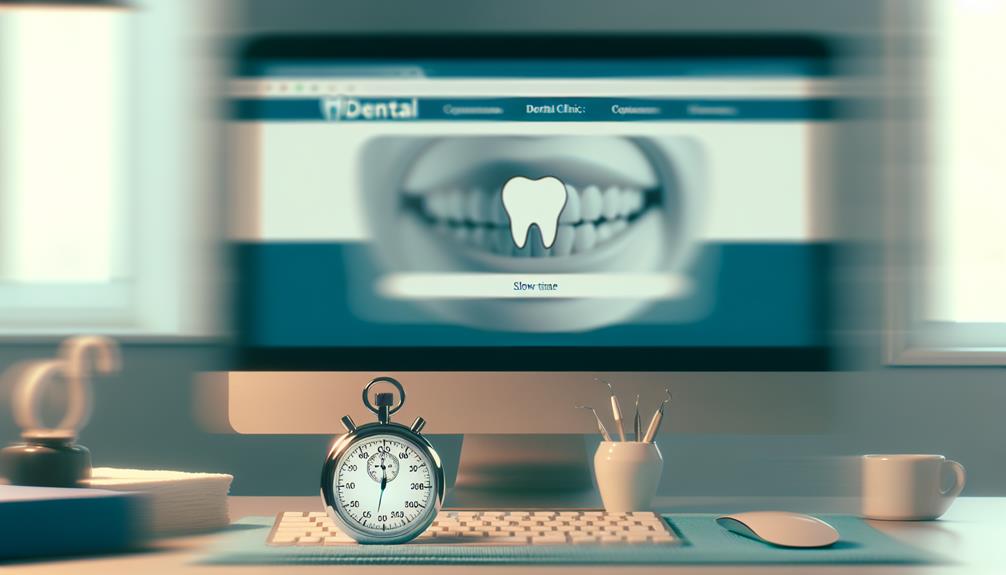Unlock the doors to higher search rankings and smoother user experiences in the realm of Dental SEO by understanding the pivotal role that page speed plays in your website’s performance.
Picture this: a slow-loading website acting as a roadblock to your online visibility and patient engagement.
But fear not, for within these lines lie the keys to not only comprehend the impact of page speed on Dental SEO but also to navigate the realm of optimization strategies that can propel your dental practice to new digital heights.
Importance of Page Speed in Dental SEO
In the realm of Dental SEO, the significance of page speed can’t be overstated as it directly impacts user experience and search engine rankings. When a user visits your dental website, they expect fast-loading pages that provide them with the information they need promptly. If your website takes too long to load, users are likely to abandon it, leading to a high bounce rate and a negative impact on your conversion rate.
From an SEO perspective, search engines like Google consider page speed as one of the ranking factors. Websites that load quickly tend to rank higher in search results, increasing their visibility to potential patients. Moreover, fast-loading pages enhance user experience, leading to higher engagement and increased chances of conversion.
To improve your Dental SEO, optimizing your page speed is crucial. This can be achieved by compressing images, reducing server response time, leveraging browser caching, and minimizing redirects. By prioritizing page speed, you can create a seamless user experience, boost your search engine rankings, and ultimately increase your conversion rate.
Factors Affecting Page Speed
Factors that influence page speed in Dental SEO include server performance, image optimization, code efficiency, and browser caching. When optimizing your dental website for speed, it’s crucial to pay attention to these key elements.
Here are three factors affecting page speed that you should focus on:
- Browser Compatibility: Ensure your website is compatible with various browsers like Chrome, Firefox, Safari, and Edge. Different browsers may render your site differently, impacting load times. By optimizing for compatibility, you can enhance user experience across all platforms.
- Content Delivery: Implementing a content delivery network (CDN) can significantly improve page speed. CDNs distribute your website’s content across multiple servers worldwide, reducing the distance between the user and the server. This leads to faster loading times and improved performance.
- Code Efficiency: Clean and optimized code is essential for fast page speed. Minimize unnecessary code, leverage browser caching, and utilize techniques like minification to streamline your website’s codebase. Efficient coding practices can help reduce load times and enhance overall SEO performance.
Tools to Measure Page Speed
To optimize your dental website effectively, it’s crucial to understand the tools available for measuring page speed accurately. Utilizing tools like Google’s PageSpeed Insights or GTmetrix can provide valuable insights into your site’s performance metrics.
Importance of Speed
Regularly monitoring your website’s page speed using tools like Google PageSpeed Insights or GTmetrix is essential for optimizing your dental SEO strategy. By analyzing speed testing methods and implementing content delivery strategies, you can enhance user experience and positively impact your search engine rankings. Here are three key reasons why speed is crucial for dental SEO:
- User Experience Improvement: A fast-loading website keeps visitors engaged and reduces bounce rates.
- Search Engine Ranking Boost: Speed is a significant ranking factor for search engines like Google.
- Mobile Optimization: Fast-loading pages cater to mobile users, improving accessibility and user satisfaction.
Prioritizing speed optimization through regular monitoring and strategic adjustments can elevate your dental practice’s online visibility and competitiveness.
Impact on Rankings
Monitoring your website’s page speed using tools like Google PageSpeed Insights or GTmetrix is crucial to understanding how it impacts your rankings in search engines. Search engines like Google consider page speed as a ranking factor because it directly affects user experience.
A fast-loading website enhances user satisfaction, leading to longer average sessions and lower bounce rates, which are positive signals for search engines. Improved user experience due to quick page speeds can also positively impact conversion rates.
Pages that load faster tend to have higher conversion rates, as visitors are more likely to engage with your content or services. By optimizing your page speed, you not only boost your rankings but also increase the likelihood of converting visitors into leads or customers.
Optimization Techniques
How can you effectively evaluate your website’s page speed performance to optimize its SEO impact? Utilizing tools to measure loading time is crucial for enhancing user experience and boosting search rankings. Here are three essential tools to help you analyze and improve your page speed:
- Google PageSpeed Insights: Provides insights into your website’s performance on both mobile and desktop devices, offering suggestions for optimization.
- GTmetrix: Offers a detailed analysis of your site’s speed performance, highlighting areas for improvement such as image optimization and server response time.
- Pingdom: Monitors your website’s uptime and performance, allowing you to track loading times from various locations worldwide, aiding in identifying bottlenecks.
Common Page Speed Optimization Techniques
When optimizing your website for speed, image compression can significantly benefit load times by reducing file sizes without compromising quality.
Utilizing caching mechanisms ensures that returning visitors experience faster load times by storing elements locally.
Another effective technique is to minimize the number and size of CSS files, allowing for quicker rendering of your site’s styling elements.
Image Compression Benefits
Image compression plays a crucial role in enhancing page speed and overall SEO performance for dental websites. When optimizing images for your site, keep in mind these key benefits:
- Improved Page Speed: Compressed images load faster, reducing website load times and enhancing user experience.
- SEO Advantages: Search engines like Google consider page speed as a ranking factor. By compressing images, you improve your site’s performance and SEO ranking.
- Bandwidth Efficiency: Compressed images consume less bandwidth, making your website more cost-effective and accessible to users with varying internet speeds.
Caching for Speed
Optimizing your website through caching is a fundamental aspect of page speed enhancement and SEO performance for dental practices. Browser caching benefits your site by storing static files locally, reducing load times for returning visitors.
Implementing caching strategies like setting cache expiration dates and utilizing Content Delivery Networks (CDNs) can significantly improve website performance. By enabling browser caching, you allow elements like images, CSS, and JavaScript to be stored on a user’s device, cutting down on server requests and enhancing speed optimization.
Proper caching mechanisms ensure that your dental website loads swiftly, offering a seamless browsing experience for your patients. Utilizing these techniques not only boosts user satisfaction but also positively impacts your dental SEO efforts, as faster websites tend to rank higher in search engine results.
Minimize CSS Files
To enhance your dental website’s page speed and SEO performance, reducing the number of CSS files is a crucial optimization technique that demands strategic implementation. When it comes to minimizing CSS files, consider the following:
- File Compression Techniques: Utilize tools like Gzip to compress CSS files, reducing their size and speeding up loading times.
- Browser Compatibility: Ensure that your CSS files are compatible with various browsers to provide a seamless user experience across different platforms.
- Responsive Design: Opt for responsive CSS frameworks to create a mobile-friendly website that enhances user experience and SEO performance.
Image Optimization for Faster Loading
How can the quality of your website’s images impact its loading speed and overall SEO performance? Optimizing images is crucial for faster loading times, which directly influences user experience and SEO rankings. By implementing image optimization techniques, you can enhance your website’s performance and boost its visibility on search engines. Monitoring your website’s performance regularly allows you to identify any image-related issues that may be slowing down your site.
| Image Optimization Techniques | Benefits | Tools |
|---|---|---|
| Compressing Images | Reduces file size without losing quality, leading to faster load times | Online tools like TinyPNG |
| Using Proper File Formats | Choosing the right format like JPEG or PNG can optimize loading speed | Adobe Photoshop, GIMP |
| Implementing Lazy Loading | Delays loading images until they are about to be viewed, improving initial load time | Plugins like WP Rocket, Lazy Load by WP Rocket |
Leveraging Browser Caching for Improved Performance
Improving your website’s image loading speed through optimization techniques sets the foundation for leveraging browser caching to further enhance performance. By implementing caching strategies and ensuring browser compatibility, you can significantly boost your site’s speed and user experience.
Here are three key steps to leverage browser caching effectively:
- Set Appropriate Cache-Control Headers: Configure your server to send proper Cache-Control headers, indicating how long browsers should cache your site’s resources. This helps reduce server load and speeds up subsequent page loads.
- Utilize ETags for Efficient Validation: Implement ETags (entity tags) to validate cached resources with the server efficiently. This allows browsers to check if the cached resource is still valid without having to re-download it completely, improving performance.
- Regularly Monitor Performance Analytics: Use tools to analyze your website’s performance metrics. Monitor how caching impacts load times, user experience, and overall SEO. Adjust caching settings based on performance analytics to ensure optimal speed and user satisfaction.
Mobile Optimization for Speed and Usability
Enhancing mobile responsiveness and optimizing speed are pivotal factors in dental SEO strategies for boosting user engagement and search engine rankings. When it comes to mobile optimization, navigation efficiency and user experience play a crucial role. Ensure your website is easy to navigate on mobile devices by implementing clear menus and intuitive user interfaces. Users should be able to find information quickly and effortlessly.
Design layout is equally important for mobile optimization. Make sure your website’s design is responsive and adapts well to different screen sizes. This won’t only enhance user experience but also contribute to faster loading times. Additionally, focus on content relevance by displaying essential information prominently and ensuring that it’s easily accessible on mobile devices.
Frequently Asked Questions
What Are Some Common Mistakes That Dental Websites Make That Negatively Impact Their Page Speed?
You might unknowingly hinder your dental website’s performance through image-heavy pages, poorly structured content layout, neglecting browser caching, and skipping code minification. Optimizing these areas can significantly enhance your site’s page speed.
How Does Page Speed Affect User Experience on Dental Websites?
Boosting your dental website’s page speed can significantly impact user experience. Studies show a mere 1-second delay can reduce conversions by 7%. Prioritize speed to enhance engagement and improve overall satisfaction with your site.
Are There Any Specific SEO Benefits to Having a Faster Page Speed for Dental Websites?
Faster page speed boosts your dental website SEO services by enhancing mobile optimization and conversion rates. Local SEO benefits from competitor analysis, showing how speed impacts rankings. Optimize for speed to outshine rivals and attract more patients.
How Often Should Dental Websites Monitor and Update Their Page Speed for Optimal Performance?
To keep your dental website performing at its best, monitor page speed trends regularly. Updating it as needed ensures optimal performance maintenance. Stay ahead by staying proactive. Your visitors will thank you for it.
Can Slow Page Speed Affect the Overall Ranking of a Dental Website on Search Engine Results Pages?
Slow page speed can significantly impact your dental website’s ranking on search engine results pages. It affects user experience, conversion rates, and mobile optimization. Monitoring and optimizing speed is crucial for maintaining a strong online presence.
Conclusion
In conclusion, optimizing your dental website’s page speed is crucial for improving your SEO rankings. Just like a well-oiled machine runs smoother and faster, a fast-loading website will attract more visitors and keep them engaged.
By implementing the right techniques and tools, you can enhance user experience, boost your search engine visibility, and ultimately drive more traffic to your dental practice.
So, don’t overlook the importance of page speed in your SEO strategy – it can make a world of difference.

Suraj Rana is a renowned Dental SEO Expert, deeply committed to elevating dental practices in the online landscape. With a profound understanding of technical SEO, he specializes in tailoring on-page optimization strategies specifically for the dental industry. Suraj’s extensive experience spans across various sectors, but his passion truly lies in transforming the digital presence of dental clinics. His expertise in dental-specific search engine optimization, combined with a data-driven approach, empowers him to develop strategies that significantly increase organic traffic, enhance search engine rankings for dental-related keywords, and ultimately drive business growth for his dental clients. Suraj Rana’s unique blend of SEO skills and dedication to the dental field make him an invaluable asset to any dental practice looking to thrive online.


